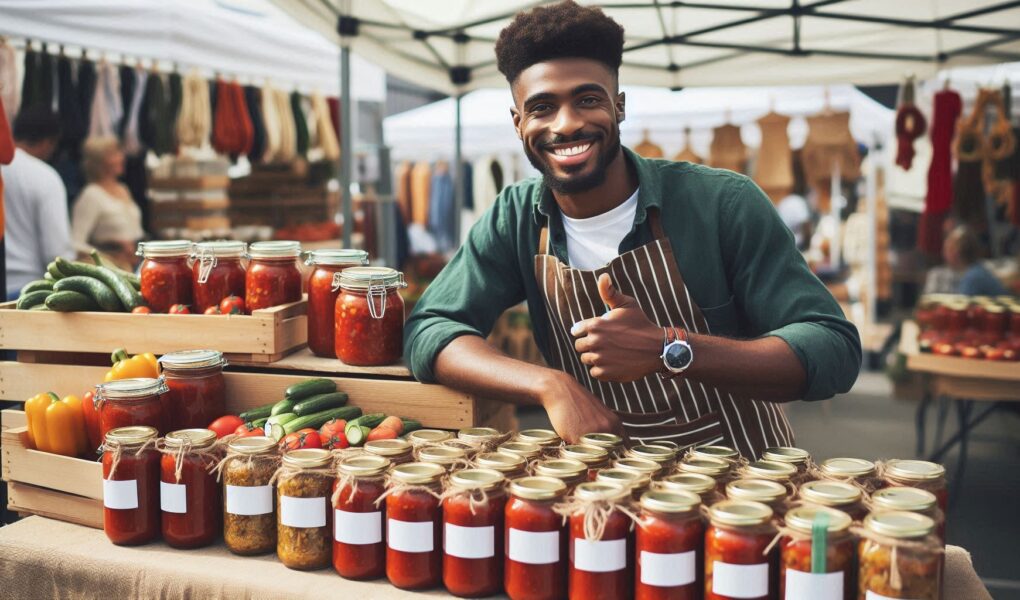Hey there!
So, you’ve got your eye on a big goal: making $1000 in a single day at the farmer’s market. First off, let me say—this is totally doable. I do it every weekend, and I’m here to tell you it’s not just a pipe dream.
With the right strategy, products, and mindset, you can absolutely crush it and walk away with a cool grand in your pocket.
I think I’ve mentioned that I made $1700 my first day selling at a farmer’s market. It was actually a lot of work, but it was WELL worth it.
Now, I’m not going to sugarcoat it—it takes work. But if you’re willing to put in the effort, I’ll show you exactly how to make it happen. Whether you’re a seasoned vendor or just starting out, these tips will help you maximize your sales and hit that $1000 mark.
Let’s get into it!
Why the Farmer’s Market is a Goldmine
Before we get into the nitty-gritty, let’s talk about why farmer’s markets are such a great place to make money. For starters, they attract a specific kind of customer—people who value quality, uniqueness, and supporting local businesses. These shoppers are often willing to pay a premium for products they can’t find anywhere else.
Plus, farmer’s markets are all about community. When you build relationships with your customers, they’re more likely to come back week after week.
And repeat customers? That’s where the real money is.
Step 1: Choose the Right Products
If you want to make $1000 in a day, you need to sell products that have high profit margins and broad appeal.
Here are some of the best options:
1. Artisan Breads and Baked Goods
Freshly baked bread, pastries, and cookies are always a hit. The ingredients are cheap, but you can charge a premium for handmade, high-quality goods. Bonus points if you offer gluten-free or vegan options.
2. Homemade Jams and Preserves
Jams and jellies are easy to make, have a long shelf life, and people love them. Use locally sourced fruits and unique flavor combinations to stand out.
3. Specialty Cheeses
If you’re into dairy, specialty cheeses can be a goldmine. Think goat cheese, aged cheddar, or flavored varieties like garlic herb or smoked gouda.
4. Fresh, Organic Produce
While everyone sells produce, not everyone sells specialty produce. Heirloom tomatoes, purple carrots, or exotic herbs can command higher prices.
5. Handmade Candles and Soaps
These affordable luxuries are always popular. Experiment with unique scents and natural ingredients to create a product people can’t resist.
6. Gourmet Spices and Seasoning Blends
Spices are lightweight, easy to package and display, and have a long shelf life. Create your own unique blends and offer recipe cards to add value. Think of something that you can add a few of your blends to, to create samples for potential customers. (Samples sell product. Don’t forget that.)
7. Fresh Flowers and Plants
Fresh-cut flowers, potted plants, and herbs are always in demand. They’re relatively inexpensive to grow but can be sold at a premium.
8. Homemade Pasta and Sauces
Fresh pasta paired with homemade sauce is a winning combination. Offer a variety of shapes and flavours to keep things interesting. Again…samples sell product. If you can prepare even a small amount of pasta or cut up cubes of bread (maybe trade with a bread vendor) and dip in your sauce, I promise that you’ll sell a LOT more!
9. Craft Beverages
From cold-pressed juices to kombucha to small-batch coffee, craft beverages are trendy and profitable.
10. Anything You Can Make on a BarbeQue
I know I know…sounds simple, but hear me out; When you’re walking through a farmer’s market, what do you find yourself subconsciously keeping an eye out for?
FOOD! Right?
Burgers, hot dogs, fries, etc. are ALWAYS a huge hit at farmer’s markets.
Step 2: Price Your Products Strategically
Pricing is key to hitting that $1000 goal. You need to find the sweet spot where your prices are high enough to maximize profit but low enough to attract customers.
Here’s how to do it:
- Calculate Your Costs: Make sure you know exactly how much it costs to produce each item, including ingredients, packaging, and labor.
- Research the Market: Check out what other vendors are charging for similar products. You don’t want to be the most expensive booth, but you also don’t want to undervalue your work.
- Offer Tiered Pricing: Create different price points to appeal to a range of customers. For example, sell small jars of jam for $5 and larger ones 10.
Step 3: Create an Irresistible Booth
Your booth is your storefront, and first impressions matter. Here’s how to make yours stand out:
- Invest in Quality Displays: Use attractive tables, shelves, and signage to showcase your products. A well-organized booth looks professional and inviting.
- Use Eye-Catching Packaging: People eat with their eyes first. Invest in packaging that’s both functional and beautiful.
- Offer Samples: Let customers taste or try your products. Once they experience how amazing they are, they’ll be much more likely to buy.
Step 4: Master the Art of Selling
Selling at a farmer’s market is all about building relationships. Here’s how to do it:
- Be Friendly and Approachable: Smile, make eye contact, and greet everyone who walks by. A little kindness goes a long way.
- Tell Your Story: People love knowing the story behind the products they buy. Share how you got started, why you’re passionate about what you do, and what makes your products special.
- Upsell and Cross-Sell: If someone buys a jar of jam, suggest they try your artisan bread to go with it. The more they buy, the closer you get to that $1000 goal.
Step 5: Promote Like a Pro
You can’t make $1000 in a day if no one knows you’re there. Here’s how to get the word out:
- Leverage Social Media: Post about your upcoming market day on Instagram, Facebook, and TikTok. Share behind-the-scenes content, product photos, and special offers.
- Collaborate with Other Vendors: Partner with other vendors to cross-promote each other’s products. For example, if you sell bread, team up with someone who sells jam.
- Offer a Special Deal: Create a limited-time offer to incentivize customers to buy. For example, “Buy 3 jars of jam, get 1 free.”
Step 6: Track Your Progress
To hit $1000, you need to know how close you are throughout the day. Here’s how to stay on track:
- Set Hourly Goals: Break down your $1000 goal into smaller, hourly targets. For example, aim to make $200 by 10 AM, $500 by noon, and so on.
- Keep a Tally: Use a notebook or a simple app to track your sales in real time. This will help you stay focused and motivated.
- Adjust as Needed: If you’re falling behind, don’t panic. Try offering a flash sale, giving out more samples, or engaging more with customers to boost sales.
Real-Life Example: How I Made $1000 in a Day
Let me share a quick story from my own experience. My first summer doing farmer’s markets, I decided to go all-in on selling a baked food product from a family recipe at my local farmer’s market.
Here’s what I did:
- Prepped Like Crazy: I spent the week before the market making as much product as possible. I have no idea how much product I brought, but I sold out after selling $1700 worth.
- Priced Strategically: I priced my product hot and ready to eat for $8 each, and I also sold them frozen in packs of 3 for $15.
- Created a Simple Looking Booth: I bought 3 white folding tables, a large 10′ x 2′ banner with my company name and logo on it, and a 10′ x 10′ canopy.
- Engaged with Customers: I greeted everyone with a smile, offered samples, and shared my story.
Final Thoughts
Making $1000 in a single day at the farmer’s market is absolutely achievable—but it takes planning, effort, and a little bit of hustle. Choose the right products, price them strategically, create an irresistible booth, and master the art of selling. Promote like a pro, track your progress, and don’t be afraid to adjust your strategy as needed.
Most importantly, have fun! Farmer’s markets are all about community, creativity, and connection. When you pour your heart into what you do, it shows—and customers will respond.
So, what are you waiting for?
Get out there and make that $1000! And when you do, come back and tell me all about it. I’d love to hear your success story.
P.S. Don’t forget to check your local regulations and permits before you start selling. Every market has its own rules, and you don’t want any surprises!



